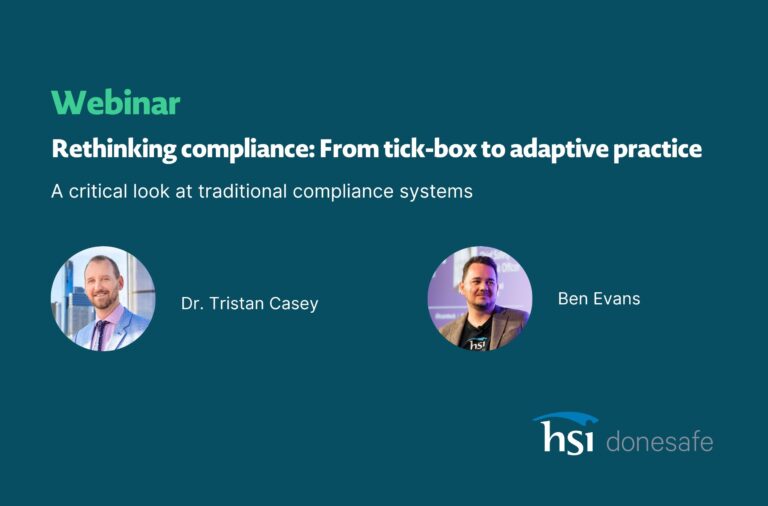
Behavior-based safety (BBS) is the process of conducting routine safety observations to give management and employees a picture of overall organizational safety. BBS is successful because it encourages and cultivates safety-promoting behavior among individual employees. Since it promotes individual and peer accountability, tracking behavior-based safety is an integral part of creating a culture of safety.
How does BBS work?
The goal of behavior-based safety is to increase organizational safety by encouraging safety-promoting behaviors. It typically involves observations performed by trained employees, who make note of safe and unsafe behaviors and working conditions.
Since BBS is based on regular and routine safety observation, employees can expect to be held accountable for behaviors that do not meet safety standards. This approach places emphasis on each employee to take ownership of their behavior and actively adapt their approach to preventing incidents. It also encourages collaboration on safety goals by being attentive to the behavior of peers or fellow employees.
Keep in mind that the goal of BBS is accountability rather than punishment and that a successful BBS program focuses on positive reinforcement and improvement. When BBS is done right, employees are given feedback on their behavior and encouraged to act in ways that enhance safety. Observations are then used to improve safety policy, leading to a feedback loop between employees, observers, and safety managers.
Adopting a BBS model also helps change the mentality that tracking, reporting, and compliance “on paper” is all that matters. Instead, the focus is on daily, routine, safety-enhancing behaviors rather than checking items off a list or form every few weeks or months.
Behavior-based safety creates a chain of events that improve overall safety. Routine observation highlights the fact that individual actions, good or bad, can affect the entire organization’s safety record. This heightened awareness increases employee safety and reduces the organization’s overall level of risk. Recently, OSHA has also recommended increasing employee and manager involvement in identifying safety risks, and a BBS program is a great way to do that.
Why do I need a BBS system?
Behavior-based safety only works if there is regular and consistent observation. Automating and improving the consistency and frequency of observation will have positive effects on the quality of reporting and follow-through. Software is one of the easiest ways to achieve that.
One of the major advantages of BBS software is that it allows for more routine tracking, as it removes the need for safety managers to be physically present on site. Giving workers ease of access and reporting in real-time makes for quicker communication and opportunities for addressing concerns.
As with other domains of EHS, BBS software saves time and improves efficiency by automating processes that are usually repetitive, manual, or require multiple levels of monitoring and tracking. As an added bonus, the software also prevents the kinds of accidental errors that arise from trying to manage lengthy checklists.
BBS software automatically includes all key aspects of an organization’s behavior-based safety policy, including capturing, tracking, reporting, and analysis with real-time reports and alerts. Managers have the option to adopt custom checklists that align with each worker’s job function, location, and individual daily tasks.
Relying on software can also mean the difference between faulty and accurate data, Regular BBS tracking is very data-intensive. Depending on the size of the organization, it can involve recording hundreds, or even thousands, of data points per week. Software crunches the numbers for you and prevents typical user error and oversights arising from manually inputting so many data points. It also saves time for employees, who no longer have to spend valuable working hours inputting data.
Overall, BBS software allows regular tracking of employee reports and observations and helps leadership get a better sense of the root causes of potential safety risks. It also ensures that urgent risks are reported and addressed in real-time.
Building a software-based BBS program: Where do I start?
Implementing a software-based BBS program is a step-by-step process, and each step is critical to ensure the platform is implemented and used correctly.
Secure management buy-in
If management is not on board or doesn’t understand the importance of BBS tracking, the best software won’t make much of a difference. It is crucial to communicate the value of BBS software in terms of how much it would benefit the organization’s overall safety strategy.
Set expectations
Once leadership is on board, it’s time to communicate expectations to all employees. This may require a learning curve, depending on the company’s previous approach to tracking safety behavior. Clear communication and updates are necessary at this stage, especially if employees are not accustomed to routine safety checks.
Communicate and share resources
During the transition period, remember to practice patience and positive reinforcement and give employees the resources they need to adapt to the new policy. Create a checklist of behaviors and a timeline for routine observations, and familiarize employees with these changes. Using software to keep track of lengthy forms and maintain a regular observation schedule can make the transition to a BBS model as seamless as possible. The more intuitive and user-friendly your BBS software, the more painless this process will be.
Use data to your advantage
BBS software offers straightforward reporting and analytics to share with your teams. This feature is especially important at the initial stages of implementation, to show the successes and return on investment of the product. As the implementation progresses, you’ll have the opportunity to collect and share BBS tracking data with relevant departments on a specific timeline, such as monthly or quarterly.
Remember to stay flexible
Another key feature for behavior-based safety tracking is the built-in flexibility of BBS software. BBS should be dynamic rather than rigid and set in stone, and software allows you to reevaluate or adjust as needed. While it’s very convenient to use software to automate processes and “set it and forget it”, its good practice to review and adjust metrics, standards, or procedures as needed. This will ensure the overall BBS strategy remains understandable to all employees and continues to meet the organization’s needs.
***
BBS software greatly simplifies what was once a tedious process. Having data at your fingertips promotes accountability, provides an ongoing rationale for routine safety checks, and increases awareness of everyone’s individual and collective role in reducing incidents.
When transitioning to a behavior-based safety model, a transparent implementation process is important for ensuring employee and leadership involvement. BBS software is a great asset to have on your side, as it helps facilitate accountability, ownership, and adaptability. After a brief period of setup and adjustment, BBS software will most likely become an indispensable part of your safety strategy.
Share:



